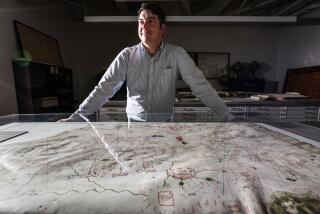Elrey B. Jeppesen; Aviation Pioneer Founded Map Firm
- Share via
Aviation pioneer Elrey B. “Jepp” Jeppesen, who began flying in a $500 World War I surplus plane and went on to publish aviator navigation charts that have become standard cockpit equipment, has died. He was 89.
Jeppesen, whose first pilot’s license was signed by Orville Wright, died Tuesday at home in the Denver suburb of Englewood, said Janet Conner, a spokeswoman for Jeppesen Corp., the aviation map company he sold more than 30 years ago.
“Jepp’s work has saved a lot of lives,” Jack Leffler, who founded Seattle’s Museum of Flight, once said. “People who didn’t use his charts ran into mountains.”
Jeppesen flew airmail, beginning in 1929, over the Rocky Mountains between Cheyenne, Wyo., and Salt Lake City in an open-cockpit Boeing 40B4 biplane for Boeing Air Transport, the forerunner of United Airlines.
In those days, navigation was mainly a matter of knowing the railroad tracks, hills, water towers, buildings, highways, canyons--even the trees along a given route. Veteran pilots, however, jealously guarded their knowledge of the terrain, protecting it as a trade secret.
Jeppesen initially had trouble until other pilots began filling him in:
“Never pass this beacon on the north. You’ll smack a hill. . . .”
“When you reach this intersection, turn right and follow the railroad tracks for 10 minutes. . . .”
Jeppesen began jotting down the landmarks in a 10-cent, loose-leaf notebook, and other pilots began using his information.
He collected data for his charts, which were first published in 1933 and sold for $10, by driving the mail routes by car, climbing mountains and smokestacks with altimeters strapped on his back and gathering information from city and county engineers.
He briefly tried making handwritten copies, but soon resorted to printing a few copies of what became the Jeppesen Airway Manual. The first book included landing approach procedures for 50 airfields from Chicago to Oakland.
The company he began with his charts, Jeppesen Sanderson, was grossing $5 million a year and had 200 workers when he sold it in 1961 to Times Mirror Corp., the parent company of the Los Angeles Times. Today, operating out of Englewood, Colo., Jeppesen Corp. grosses $80 million annually.
There was an effort to name Denver’s new $4.9-billion airport after Jeppesen, but he declined, saying that “nobody would have known where Jeppesen Airport was.” Instead, the terminal at Denver International Airport was named for him.
Jeppesen recalled the beginnings of the airline industry and a few close shaves in an interview a few years ago.
“You’d always get a thrill when those old single-engine biplanes would quit,” he told the Associated Press, adding that the remedy was to “just glide it down.”
One night he put down a mail plane with a dead engine in a storm near Omaha. He came to “stumbling around in the snow with the parachute between my legs about 100 feet from the burning plane.”
And then there were a few times he flew a DC-3 on one engine over the mountains. “That was kind of ticklish,” he said.
Jeppesen was born Jan. 28, 1907, in Lake Charles, La., and grew up in Hood River, Ore. He started flying at age 16 in a World War I surplus plane he bought for $500 and went barnstorming with Tex Rankin’s Flying Circus of Portland.
“Those old open airplanes--you felt like a bird, a part of the airplane,” Jeppesen said. “God, I’d love to do it all again.”
He is survived by two sons and five grandchildren.
Associated Press contributed to this story.
More to Read
Inside the business of entertainment
The Wide Shot brings you news, analysis and insights on everything from streaming wars to production — and what it all means for the future.
You may occasionally receive promotional content from the Los Angeles Times.








